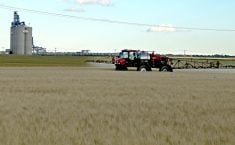Al Scholz, a farm business management adviser based in Saskatoon, says Walmart’s new initiatives have potential to help farmers.
Walmart is known for taking the lead through continuous innovation and improvement. It’s the world’s largest company with sales of more than $1 billion per day, two million employees and a supply chain that circles the globe through more than 100,000 other business ventures.
Efficient supply chain management is the key to Walmart’s profitability, which pioneered just-in-time inventory in the retail industry. The Walmart model is one of the all-time leading business strategies in any sector. This model features a superefficient production process in which each operation – purchasing, distribution and sales – is linked to the next in a continuous just-in-time chain.
Read Also

New coal mine proposal met with old concerns
A smaller version of the previously rejected Grassy Mountain coal mine project in Crowsnest Pass is back on the table, and the Livingstone Landowners Group continues to voice concerns about the environmental risks.
Today, Walmart is vying to be the world’s top corporate eco-warrior and will once again change the way everything is done.
Its efforts have won some unlikely allies. Green groups are now as likely to praise the company’s work and form partnerships with it as to criticize and protest against it.
In July 2009, Walmart announced the goal to develop a global sustainability index. It stated: “Our customers desire products that are more efficient, last longer and perform better. They want to know the product’s entire life cycle. They want to know the materials in the product are safe, that it is made well and is produced in a responsible way.”
The sustainability index has three goals aimed primarily at suppliers:
• supplier sustainability assessment of the more than 100,000 suppliers;
• life cycle analysis database, from raw materials to disposal, and managed by Arizona State University and the University of Arkansas;
• a simple tool for customers, a convenient and easy way to understand the process so they can make choices and consume in a more sustainable manner.
In March 2010, Safeway became the first founding member of the Walmart-initiated sustainability consortium. This shows the entire retail system is changing.
On Oct. 14, 2010, Walmart unveiled its global sustainable agriculture goals. The media release stated: “This commitment to agriculture will help small-and medium-sized farmers expand their businesses, get more income from their products, and reduce the environmental impact of farming, while strengthening local economies and providing customers with long-term access to affordable high-quality fresh food.”
The sustainable agriculture strategy has three components:
• support farmers and their communities;
• produce more food with fewer resources and less waste;
• sustainably source key agricultural products.
If successful, Walmart will lead the evolution of Canada’s agriculture and food policy and single-handedly accomplish the sustainability and profitability goals that many farm organizations strive for.
Walmart Canada’s goal is to purchase 30 percent of its produce assortment locally on an annual basis. This is a staggering amount and an exciting opportunity for innovative Canadian growers.
It’s not certain how Walmart will continue to provide food products at the lowest price and, at the same time, help small-and medium-sized farmers get more income from their products.
However, the skeptics are falling away, and given Walmart’s impressive track record on transforming the economy, astute farm managers will keep a sharp eye for new market opportunities within their value chain.
















